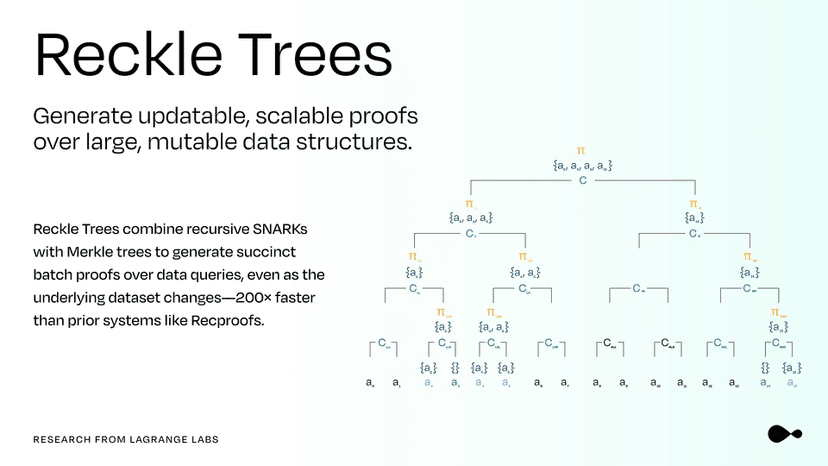In the years I have written about cross-chain, the four words I fear the most are 'trust intermediary'. Bridges are one of the biggest black holes in Web3: assets are controlled by multi-signature committees, a script error can lead to systemic accidents, and users have to wait for a group of people to wake up and sign to withdraw. It wasn't until I tried Lagrange's State Proofs (cross-chain state proofs) that I discovered another path: no need to find someone to endorse, directly bringing the 'mathematical certificate' of the source chain's state to the target chain, where the target chain contract only needs to verify once, allowing authorization and subsequent operations to be completed in the same transaction. The official case showcased a Solana→Polygon DID scenario: users submit the decentralized identity state of Solana as proof to the DApp on Polygon, and after verification, the contract allows them to directly deposit into a 'permissioned pool', all non-interactive, without needing to perform any actions on the original chain. For users, it means 'one submission, one step to the goal'; for developers, it is equivalent to transforming cross-chain from 'asking a group of people to testify' to 'asking mathematics to testify'.
This idea brings several engineering attributes that I particularly like. The first is non-interactivity: the submitter can be an untrusted third party, and the contract only checks whether the proof is self-consistent; this is much easier than traditional message bridges or light client polling. The second is aggregability: multiple states can be combined into one proof, and the target chain only needs to verify once, significantly reducing Gas costs; this is especially useful in scenarios of 'multi-chain behavior aggregation scoring'. The third is self-descriptive: the proof contains 'which chain I come from, at which height, and which position of the state', making debugging and auditing clearer. In other words, State Proofs reconstruct the core issue of 'cross-chain' from 'who do you trust' to 'what evidence can be verified by anyone'.
I have implemented three lightweight use cases. The first is fund whitelist cross-chain integration: maintaining a 'compliance address list' on the source chain and periodically transferring the state in the form of proofs to the target chain, allowing DeFi protocols to directly release funds after verification, eliminating the need to maintain centralized APIs; this type of state updates infrequently and does not have high real-time requirements, making it very suitable. The second is cross-chain verification of investment qualifications: activities cover multiple chains, and I issue rewards based on 'cumulative interactions across the network', without requiring users to sign/reconcile on each chain separately; one proof is sufficient. The third is on-chain consumption of KYC results: compliance platforms complete KYC within the private domain and provide 'passed/not passed + proof', with business parties collecting evidence on-chain; compliance data does not leave the domain, but the certificates can be traced and revoked.
It should be reminded that cross-chain is not about 'proving everything'. I set two 'calm thresholds' for myself: first is the value threshold—only when the cross-chain state is directly related to the safety of funds, permission toggling, or compliance checks does it warrant the cost of proof; second is the timeliness threshold—for states that have a strong dependence on 'near real-time', it is better to use native bridges or light clients rather than forcibly squeezing everything into zero-knowledge circuits. In engineering, correctness is as important as adaptability.
From an ecological perspective, Lagrange's State Proofs and SQL co-processing are two sides of the same coin: the former brings in 'facts from other chains', while the latter calculates and verifies 'historical actions from many chains' before issuing proof. Only by combining both can we support true 'cross-chain data applications'. I noticed that they announced cross-chain query optimization for ecosystems like Fraxtal as early as 2024, and launched the public testnet Euclid in 2024, making it easier for developers to run such patterns. These nodes indicate that this is not just talk, but a step-by-step approach to solidifying the combination of 'cross-chain + verifiable computation'.
My personal judgment on cross-chain is simple: remove artificial endorsements and retain user experience. With State Proofs, cross-chain no longer has to choose between 'security' and 'usability'. Treating 'mathematical certificates' as system defaults is the future I'm willing to bet on. I will continue to observe: ① whether proof latency can stabilize below the minute level; ② whether verification costs across different chains are controllable; ③ whether aggregated proofs can be reused by more application layers. As long as these three aspects continue to improve, cross-chain can gradually transform from the 'most vulnerable link' to the 'most reliable link'.
@Lagrange Official #lagrange $LA

